Today, after all night rains, I took my dogs down to see if the dog park was passable. We couldn’t even make it around the park for flooding and downtown was a complete mess. Here’s a few photos.




Today, after all night rains, I took my dogs down to see if the dog park was passable. We couldn’t even make it around the park for flooding and downtown was a complete mess. Here’s a few photos.




 The following is an excerpt from my book How To Write A Novel: The Fundamentals of Fiction, Chapter 3:
The following is an excerpt from my book How To Write A Novel: The Fundamentals of Fiction, Chapter 3:
In Writing the Breakout Novel, Donald Maass identifies five basic plot elements that all plots must have. They are:
A sympathetic character
Conflict
Complication
Climax
Resolution
So, every good plot starts with character, specifically a character we can care about. Then that character encounters obstacles that create conflict. This can be another person or group of people, some natural or other issue, etc. Then the conflict is complicated by various other obstacles and barriers that stand in the way of the character resolving it. This leads to a climax wherein the character must confront the opponent—person, animal, or thing—head on and see who will win. This leads to a resolution. These five elements make up any solid, well-developed plot.
We’ve already talked about how the plot is a series of questions asked and answered, so now let’s look at a key question we must always ask to make our plots stronger: What’s the worst that can happen?
You start with conflict and then consider what the complications might be. In doing so, there may be a temptation to like the character too much and not want to make things too hard on him or her. But that is the death of good drama. Instead, you need to ask yourself, “What’s the worst that can happen?” and consider the more dire possibilities. This is what makes good drama. Maass writes: “What makes a breakout novel memorable are conflicts that are deep, credible, complex, and universal enough so a great number of readers can relate.” So, don’t go off the deepest end necessarily, choosing something so dire and outrageous that it seems too hard to believe. You want to complicate and create disasters and dangers, not create incredulity in readers.
What you do want to do is push your problem far beyond what readers might imagine. Maass suggests: “Push your characters into situations that you yourself would never go near in your own life.” Remember that the characters should speak and act in ways we only wish we had the courage to do. This is what inspires us to admire and follow them. So they will be capable of facing situations we wouldn’t dare take on ourselves. The key is to push things to utter extremes while still managing to make them feel familiar to readers. Not outlandish, then, but familiar. In other words, possible.
When we create conflict that is credible, relatable, and familiar, we create stories with tension on every page. These are the kinds of stories that keep readers turning pages and coming back time and again to the same authors for more. John Grisham, Nicholas Sparks, Michael Connelly, Jonathan Maberry, Stephen King, Joyce Carol Oates, Heather Graham, J.K. Rowling, Rachel Caine—these are examples of authors who have mastered this technique. If you want your plots to become breakout, hit stories, you must create tension on every page. Make us desperate to know what happens next. Create urgency in the questions the plot asks. This will drive the story forward, increasing the stakes and tension with each scene and page, until readers may feel they or the characters can’t possibly take anymore, but they do every time. And we are dying to know how they manage it and can possibly survive, so we stay up all night reading to find out. We’ve all read and loved books like that, right? Imagine what it would be like to write one.
One technique that aids this kind of tension is nonlinear narrative. Grisham is a master of this: constantly holding information back from his readers to surprise them with later. Nonlinear narrative is storytelling that increases tension by telling the story in a nonchronological fashion, using flashbacks and other such techniques. Basically, you start telling the story in the center of the action at the most dramatic place and then go back and fill in the backstory and details as necessary through the course of the novel.
For what it’s worth…
So someone asked me what it’s like a while ago to attend a tv taping and I never got around to posting. Here’s what BIG BANG was like.
You show up early, even noon for a 6 p.m. call to get in if you are General admission. I was VIP so I had to be there by 6:30 to keep my seat. I got there just in time due to unforeseen difficulties I won’t go into. Some shows bus you, because I was late, a security guy drove me in a golf cart, everyone else walked in escorted by ushers/security so they walked across the lot past sound stages for other shows and movies including The Conners, Mom, and Ellen. Once you got to the stage, they had metal detectors and collected cell phones and ID to identify them, putting them in zip lock bags. That was new. They didn’t used to do that but cells are much more common now. The seating is just like they showed on the making of special tonight. Bleachers raised and up stairs facing the sets with the most common apartment sets right in front of you and the rest stretching to each side.
A comedian starts warming you up around 7 and they start filming around 7:15 or 7:30. You play various games and trivia as you wait and sometimes they have you watch pretaped footage on monitors and record your laughter or just play it to bring you up to speed. In our case, they played a previous episode of the show they wanted to get better laugh track for. They had also pretaped a lot of scenes with the big name guest stars: William Shatner, Joe Magianella, Kareem Abdul Jabber, Wil Wheaton, and Kevin Smith.
So they announce the scenes and there is a loud alarm to let people know to be quiet, that tape is rolling, and then the actors play out the scene. They run it at least twice, sometimes more, and if the actors mess up, they may repeat various bits of it until they are satisfied. All the while, the warmup guy is encouraging you to act like you’ve never seen it and laugh accordingly.
They move from set to set with cameras on wheels, makeup and sound carts, etc. and a large number of crew from lighting and props people to writers, producers, sound people, cameraman, assistant directors, even hair and costume, and the director leading it all. They also have script people following continuity and taking notes or reading lines as needed for actors.
You go through each scene in order, pretaped ones being played at the appropriate time, so you can follow the storyline. The entire process can take from 3 to 6 hours or even longer. I was at one taping that ran 7 or 8 hours once. this was 3.5, mostly due to all the pretaped segments, which were over half the show. It was the D&D episode.
Somewhere in the middle, at this one, they fed us each a slice of pizza and gave us a small bottle of water. If you need a bathroom break, you just have to sneak out when they are between setups and an usher will take you.
That’s pretty much it. It can be long, the seats can be uncomfortable, and it can be cramped. But it is basically live theatre with a lot of cameras, lights, mics and stuff partially blocking your view and the sets are a bit more distant than a stage and spread out so they are sometimes off to the side and you have to watch the monitor to follow the action. In this case, they actually rolled screens in front of the set not being used at the time. Never been to a taping where they did that before and I found it kind of annoying as it helped further block our view, but that’s what they did.
Also, Kaley and Johnny came up and chatted with us briefly at one point as well.
So that’s what it’s like to go. Now, if you are guest of crew, which I was not this time but have been in the past, you get to go mingle with cast and crew on the set after the taping, but I didn’t do that here. I did it for CHEERS and CHARLES IN CHARGE and SEINFELD back in the day though.
 The following is an excerpt from my book How To Write A Novel: The Fundamentals of Fiction, Chapter 1:
The following is an excerpt from my book How To Write A Novel: The Fundamentals of Fiction, Chapter 1:
“If a powerful problem is a novel’s spine,” Donald Maass writes in The Breakout Novel, “then a powerful theme is its animating spirit … It starts with you having something to say.” Theme is one of those topics that makes many people’s eyes glaze over. They think of the theme papers they hated writing in school, perhaps. Or find it abstract and hard to conceive. But theme can and should form the unifying narrative structure of your well-written novel. What is theme? Theme is what a story, at its heart, at its moral core, is really trying to say, what it’s about. It’s why you are telling the story. It is what you have to say. Theme, in essence, is not the argument, but the moral derived from it. It is the lesson(s) and life truth(s) embedded and demonstrated through your story.
In Theme and Strategy, Ronald B. Tobias defines theme as “the central concern around which a story is structured.” He writes, “Theme is your inertial guidance system. It directs your decisions about which path to take, which choice is right for the story and which isn’t.” In essence, theme is what unifies the whole and informs it beyond just a story about a guy or girl who did so-and-so into something memorable with lasting impact that speaks to the human condition. Choosing the right theme will help you unify your story. It isn’t something you should just wing or make up as you go, but something you should think about early on, even as you plan your story, and keep in your mind with every scene you write.
Maass suggests three facts to keep in mind:
All stories are moral.
Readers tend to seek out stories that are in line with their beliefs.
Fiction is most compelling when it pulls readers into points of view that are compelling, detailed, and different.
Readers crave insight on the world around them. They want to be pushed to expand their minds and see things differently, through different eyes. Readers become most engaged when the characters’ beliefs capture their attention and make them think. Whether you know it or not, you have something to say, and having the courage to say it through your story and characters will imbue your novel with power that makes it memorable and lasting. Deep down, all writers believe they have something that must be said, some insight on the human condition the world cannot do without, and these demonstrate their own morality and views of right and wrong in the universe. Ask yourself what that is, and let your story speak to that. Have it in mind as you write. This will create a unified story with resonance far beyond just entertainment. As Maass writes, “stories without fire cannot fire readers.”
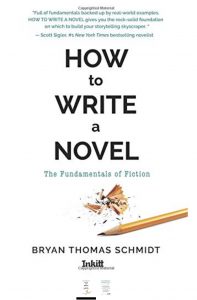 Because readers are moral people, they inherently look for the moral compass that drives characters in fiction. Whether they agree with it or not is not the primary concern—understanding it is. Powerful beliefs and messages imparted through characters are far more effective than writers preaching or teaching directly, because characters who have beliefs that drive them will take concrete actions that reflect those beliefs. The consequences of these actions then speak powerfully about life, people, and more in ways that direct lessons can never accomplish. The key is embedding these morals and beliefs in the characters’ actions. When characters live what they believe, readers will accept the validity of those beliefs and be impacted by the results.
Because readers are moral people, they inherently look for the moral compass that drives characters in fiction. Whether they agree with it or not is not the primary concern—understanding it is. Powerful beliefs and messages imparted through characters are far more effective than writers preaching or teaching directly, because characters who have beliefs that drive them will take concrete actions that reflect those beliefs. The consequences of these actions then speak powerfully about life, people, and more in ways that direct lessons can never accomplish. The key is embedding these morals and beliefs in the characters’ actions. When characters live what they believe, readers will accept the validity of those beliefs and be impacted by the results.
Tobias suggests several major patterns, which can be summarized as follows:
Plot as Theme—Much of popular fiction is driven by this theme, in which plot is paramount over any other concerns. Escapism is the goal here, and as such, while the novels may not carry long-lasting moral messages, they earn big points with readers and generate bestseller after bestseller. They are not striving for great literature but rather great entertainment, and this has made them hugely successful. Agatha Christie, George Lucas, Steven Spielberg, Dan Brown, John Grisham, and many more create works that fall readily into this category.
Emotional Effect as Theme—Terror, Suspense, Romance, Comedy—in this case the emotional effect of the story is the driving theme. Works by authors such as Stephen King, Peter Straub, Gini Koch, Christopher Moore, John Grisham, Heather Graham, Nora Roberts, Nicholas Sparks, and more deal with this theme.
Style as Theme—This theme encompasses a small minority of movies and books because the theme is the artistic style and approach rather than other concerns. The art films and literary novels by auteurs such as John Hawkes, Ingmar Bergman, Federico Fellini, Margaret Atwood, and more have this focus.
Character as Theme—Character studies, like style-themed art, also lend themselves to literary concerns. The focus here is the characters, their growth, and how the world and events of the story affect them. Mark Twain’s The Adventures of Huckleberry Finn, Charles Dickens’s David Copperfield, Gustave Flaubert’s Madam Bovary, and films like Raging Bull, The Great Santini, Taxi Driver, and The Godfather embody this approach.
Idea as Theme—Of all the patterns, this one is most successful at creating memorable events and characters that jump off the page. Idea-themed works affect us profoundly, change the world, change lives, start wars, or at the least, make us think because the whole point of ideas is to make us ponder them, ask questions, discuss, and draw new conclusions. These are often the books whose themes are erased during conversion to movies, leaving us to complain that “the book was better.” Idea as theme is less cinematic, less exciting, but its power cannot be denied. Examples include Robinson Crusoe, Don Quixote, The Graduate, and Shane.
Moral Statement as Theme—The most dangerous of theme categories, this one is most likely to become preachy and heavy handed and turn readers off, so it must be used with great care and attempted only by skillful hands. If the characters are sincere and the plot gripping and storytelling is your focus, though, you can pull this off. According to Tobias, Fatal Attraction and Wall Street are two examples of films that fall in this category. In both cases, the moral results from the story rather than the other way around.
Human Dignity as Theme—These are the stories where the fight to hold on to dignity in spite of circumstances is the focus. Stories like One Flew Over the Cuckoo’s Nest, Rocky, On the Waterfront, Gladiator, and even Roots employ this type of theme.
Social Comment as Theme—Criticizing or shining a light on our culture can be accomplished with great power using fiction. The trick here is finding the right story. Great examples are The China Syndrome and The Grapes of Wrath. The key is to let the characters’ convictions argue for you.
Human Nature as Theme—“What is Man?” is a question that has been explored for centuries and still captures readers’ interest. Stories that fit here include Deliverance, Lord of the Flies, and Robinson Crusoe. (Note: Stories can combine more than one theme. More on that later.)
Human Relations as Theme—Terms of Endearment, Ordinary People, Love Story, many a Nicholas Sparks book like The Notebook or The Wedding, and more all explore this theme where the relation of humans in community, small or large, is the focus.
Coming of Age as Theme—This one I know a lot about as it has been the theme of six of my novels and several short stories to date. The exploration of finding one’s self and confidently staking one’s place or recognizing one’s role and purpose in the universe is a theme found in Star Wars, Rocky, Harry Potter, The Hunger Games, Ender’s Game, and many, many more.
Once you know your theme or themes, you must then decide several things:
1. Who are the characters who can best embody this theme?
2. What plot is best suited for the theme?
3. What kind of setting will best fit the characters and actions necessary to portray the theme?
4. What voice and style is best suited to the theme?
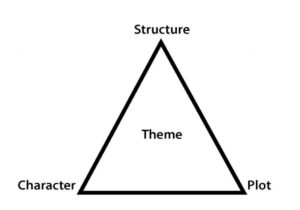 All together, structurally, Theme works with Plot and Character as shown in this diagram.
All together, structurally, Theme works with Plot and Character as shown in this diagram.
Your theme informs all these decisions, which is why knowing the theme first is so important. As the diagram demonstrates, theme is at the center of the core elements of your story’s structure. Additionally, many stories explore more than one theme. If the themes are compatible, this is a very powerful and easy thing to do.
As moral people, readers will turn to fiction for affirmation of their values or the values that underpin the world as they see it. They seek deeper understanding, answers to questions, and more in great stories, driven by the desire to know that what they believe is right. Maass suggests it matters less whether the moral is widely accepted than that it is developed in depth. “The key is your protagonist,” he writes. “If we believe in him, we will believe what he believes.”
We buy into Star Wars because Luke Skywalker believes so passionately in his cause—the Force, the right of the Rebels over the Empire, good versus evil, and what is just. The same can be said of Rocky and many other films, even The Godfather, wherein the protagonist is a criminal corrupted by his world and relationships over the course of the film. The viewer’s agreement with the decisions being made is less important than the conviction of the character. It is in the character’s anger, weeping, fear, and determination that we are inspired to believe, that readers feel it is imperative to know their stories. This is how knowing your theme and developing every scene from that perspective can transform a simple, ordinary story into a life-changing, memorable classic.
So, whether you are a planner or a pantser, outliner or discovery writer, thinking about theme and allowing it to inform your writing will make the difference between your novel being plain or something special, blending in or standing out from the pack. Theme is that vital, that key. And so, as you move forward to plan your premise and the structure that will best bring it to life, theme is an important component of your process which must be considered and carefully weighed.
For what it’s worth…See you next Wednesday.
When I started this blog, my goal was to help and entertain people with interesting experiences and posts based on my experience and knowledge. I also made a commitment to post twice weekly, and soon my blog was getting several thousands hits a month, at its height reaching into the 10s of thousands. Then I ran into some trouble and burned out, so I took a break. But I have missed it and missed my subscribers and the interaction. So I decided the time was ripe to give it another try. But before I do, there’s something I need to address.
I have zero tolerance for anyone who reads a post, asks the poster for clarification of meaning, then, upon receiving it, refuses to accept it. That is tantamount to calling someone a liar. And frankly, unless you can read minds, you are not in a position to deny the veracity of their explanation. I have even less than zero tolerance for people who never ask the author to clarify, choosing instead to read things into stories and then hold authors accountable for them when the authors insist that interpretation or meaning was never intended. It is the source of a lot of online bullying and attacks against authors and creators, and it is ridiculous.
One of the amazing things about art is how it can touch individuals differently. You put a piece out there and it takes on a life of its own drawing out meanings and emotions you never expected from people. But those reactions are based on their personal experiences, their culture, their references, etc. so blaming an author for them is ridiculous. The assumption that the author is some sort of bigot or -phobe or -ist of some sort is arrogant and self-serving and more about the reader and his or her inclination to take easy offense and be overly sensitive than it ever is about the authors being blamed or attacked. This makes it very difficult for some authors and leads to slander and ongoing acrimony that can last years. Having been through this two or three times, I speak from experience.
I wish people would accept and realize that what they bring to art has as much to do with how they experience it as any subliminal thing they might suppose the author brought, and nine times out of ten, is way more responsible than author intent for their own reactions. And the others who then jump on the bandwagon at that author’s expense to elevate themselves and act like high moral authorities are even worse. Generally, all of them together are people who have never done anything but talk about what they believe. Rarely have they put it into genuine, meaningful action.
For example, I so believed in the cause of bringing arts education opportunities to the disadvantaged that I founded a nonprofit and lead teams of artists overseas for eight years to the developing world to teach workshops. It required me to take weeks at a time off from work and to raise thousands of dollars in funding. The reward was not monetary but spiritual: I learned as much from them as they did from me and made some friendships to last a lifetime. But I also stayed in cinderblock homes with no heat in winter the hottest of heat with no air conditioning, I suffered diarrhea and other consequences from unusual dietary changes and other circumstances, even dealt with lack of proper sanitary facilities. And I did it without complaint because I knew I was making a difference. To this day, I have students who have gone on to great success in the arts in Mexico, Ghana, and Brazil and do me proud, and I maintain lifelong friendships with dozens of them. Most of the online trolls perpetrating these attacks wouldn’t dream of such sacrifices nor have the willpower to found a nonprofit and actually make it happen, and it’s too bad, because if they did they’d learn there are a lot of people in the world they claim to support who don’t see the world the way they do about things either. Many of my students who are Facebook friends are aghast when They see me treated as I have been and accused of various biases that seem the opposite of their experience of me. That’s because they know the real me, not the manufactured one of my accusers.
So I am putting it out there clearly for all to see: if you have questions about the meaning of something I post, the onus is on you to click the contact link and ask me for clarification. If you can’t be bothered, neither will I. I won’t take responsibility for explaining myself, and I won’t entertain or interact with those who try and twist my words to use them against me because they perceive me to be “not one of them.” I just have better things to do with my time. I enjoy and value relationships with people of all backgrounds, cultures, races, religions or lack thereof, etc. and I appreciate the perspective it provides. This blog will continue to celebrate that. I am moderating comments but I will only disallow trolling. Everything else is fair game. No one has to agree with me or others it it must be done respectfully. Anyone who tries to engage in oneupmanship, insults, or trolling of any kind—including that described earlier in this post—will have their comments deleted and ignored.
My blog. My rules.
And I hope that helps make this a place people enjoy coming to. Not a place they and I dread. Because I’m still all about extending it forward and helping people so we can succeed and grow together, not wasting my time with those who want to cut people down or tear them apart.
To me that’s what life’s all about.
 The following is an excerpt from my book How To Write A Novel: The Fundamentals of Fiction, Chapter 3:
The following is an excerpt from my book How To Write A Novel: The Fundamentals of Fiction, Chapter 3:
The scene is the basic building block of dramatic structure for any story. If written correctly, each scene leads to another scene and another. According to Jack M. Bickham, in his book Scene & Structure, all well-written scenes use the following pattern:
Introduction and development of conflict
Failure of character to reach his goal or a tactical complication/disaster which creates a new goal
 Notice how these parallels the three-act dramatic structure of the entire story. It is not an accident. Scenes have three acts just as the entire story will. Scenes are not static. At their heart lies conflict. One character or group has a goal and others have other goals, and these meets and create obstacles to be overcome. Hence, conflict. Most scenes start with the point-of-view (POV) character walking into a place with a clear goal in mind. (As discussed in Chapter 4 the point-of-view character is the character from whose vantage point a particular scene is told.) Success of the scene dramatically depends upon your ability to interpose obstacles between your hero/heroine and the obtainment of this goal. Sometimes the goal carries over from the previous scene. Sometimes it is the overall goal in the story. Other times, it is a sub-goal required as part of the many steps to reaching the overall story goal. In any case, usually the goal is stated early on either through internal monologue or dialogue of the character.
Notice how these parallels the three-act dramatic structure of the entire story. It is not an accident. Scenes have three acts just as the entire story will. Scenes are not static. At their heart lies conflict. One character or group has a goal and others have other goals, and these meets and create obstacles to be overcome. Hence, conflict. Most scenes start with the point-of-view (POV) character walking into a place with a clear goal in mind. (As discussed in Chapter 4 the point-of-view character is the character from whose vantage point a particular scene is told.) Success of the scene dramatically depends upon your ability to interpose obstacles between your hero/heroine and the obtainment of this goal. Sometimes the goal carries over from the previous scene. Sometimes it is the overall goal in the story. Other times, it is a sub-goal required as part of the many steps to reaching the overall story goal. In any case, usually the goal is stated early on either through internal monologue or dialogue of the character.
For example, Luke Skywalker enters the workshop and cleans the droids per Uncle Owen’s instructions (goal). In the process, he finds something jammed in a slot on R2-D2 and tries to free it, unleashing the video of Leia pleading for help. When the message is unclear, he asks R2 to play the whole message and R2 refuses by first pretending not to know what he is referring to, then saying that the restraining bolt is preventing it in order to get the bolt taken off (obstacles). The disaster comes as R2-D2 escapes, forcing Luke to chase him down.
To work well and increase dramatic tension, all scenes must end badly. Whatever the goal going in, whatever the action taken, the result must be a failure of some sort. It can be an actual failure, a twisty complication, or additional unexpected tasks, but it constitutes a delay to success regardless.
But there is another key element at play as well. When the character’s goal is stated, the reader asks a question.
Goal: To get the golden key to the temple where I can retrieve the sacred scroll.
Reader Question: Will (character) get the key?
Whatever the question, the resolution (or answer) must be a negative. Sometimes a character does the get the key, but other objects are required to find the temple or open the door, and the character must go seek them before getting the scroll. The answer to the question, the disaster, the end of the well-written scene, always creates further complication on the character’s journey through that story.
There are several key points to keep in mind when determining goal, conflict, and resolution:
1. The goal of each scene must clearly relate to the larger story question; the question evoked in readers by the stated goal of the character for the major story arc.
2. The conflict must be about the goal.
3. The conflict must be external, not within one’s self. Either with an object, animal, or person or more than one.
4. Point of view should be maintained from goal to resolution in the same scene. It is best not to break it up into different points of view to avoid confusion and loss of tension.
5. Disaster always works by pushing the character away from his or her goal.
6. Readers will tolerate much if you keep making things worse and worse in every scene. This is how you build tension and suspense and create a compelling read.
7. Since the end of each scene dictates what will happen after, scenes cannot be written in isolation from the overall arc, goals, conflict, etc. of the story itself if they are to work well.
Plots are made up of a series of interconnected scenes that create a larger story. Since a plot is the storyline arc of the overall book, and the book is a story that is like an argument with a premise, a plot consists of a series of questions asked and answered. What you ask when, and how soon you answer it, affects the tension and pacing of the overall story. Some questions get asked and answered in the same scene or chapter. Some carry over multiple scenes and chapters. Some may carry over to another book. Some carry from chapter 1 to the final chapter. The questions have various levels of stakes to them. More intense, important questions tend to take longer to answer. One great way to figure out if your story makes sense and has good pacing is to go through and identify all the questions asked and answered and when and where they are asked and answered. If you are missing any answers or questions, you have a problem that needs fixing.
Since some stories have several plots—usually an overarching main plot and subplots—and not all scenes relate to each plot, but all relate to the main arc in some way or affect it. All plots and subplots have three acts just like the overall story, so sometimes identifying which plot and subplot(s) relate to each scene is key to making them work and determining in what order the scenes need to occur to best tell the story. To be clear, a subplot is a lesser plot that is less important than the main driving plot and sometimes focuses around a specific character, location, or aspect of that larger plot and points readers back to it.
It is also important to know which characters are in a scene. Too many characters can make a scene confusing. And too few can make it ineffective. Most importantly, the person with the most to lose is usually the best POV character for that particular scene, so keep in mind whether you have multiple POV characters or not. That will determine your character use in each scene. Remember also that individual characters can have conflicting goals, and that can further complicate scenes by creating competing tensions or conflicts that add layers and depth to the scene and further obstacles to the resolution as well.
 In Medias Res
In Medias ResThe last point I’ll make is the number one rule of good dramatic writing I learned in film school: Get into a scene as late as possible in its action, and end the scene as soon as you can after that. The literary term for entering a scene when the action has already begun is in medias res.
Scenes are more dramatic when they start within tense moments of action or conflict, so skip all the slow buildup and setup like greetings and small talk, how the characters got there, etc. which would slow things down, and instead get right into it. Telephone scenes, scenes sitting around a table, on couches, or in a car, etc. have a casual, slow feel that does not lend itself well to drama, so these use sparingly. The pacing and power of your story will go up in spades, and your readers will thank you for it.
Here’s another example, one of my favorites: the opening scene from the film Lethal Weapon 2.
The film opens with Riggs yelling and pounding his palms on a dashboard as horns honk and traffic roars. Then he and Murtaugh are arguing about speed and strategy. They are in a car chase. We don’t yet know who they are chasing or why, but we are immediately thrust into the center of tense, fast-paced action, and the details will come. We soon learn there are two car chases with two teams of cops, and as they fight traffic and near misses with other vehicles and race to keep up with the fleeing criminals—Murtaugh driving his wife’s station wagon, which hardly seems up to the task—the bad guys start shooting and taking more and more chances. The goal is to catch the bad guys. The conflict comes from disagreements between cops and from all the obstacles.
When the bad guys ditch them in airport traffic, Riggs jumps out and continues the chase on foot until Murtaugh untangles the station wagon and catches up. Riggs then insists on driving, and he pushes the car even more to its limits, practically destroying it in the process. So now they are fighting each other as well (more conflict). Then the other chase ends at an intersection, where cars collide and a helicopter comes in to rescue the bad guys with automatic gunfire leading to a shootout with cops (Failure 1). Riggs and Murtaugh, meanwhile, continue their chase until their baddie flips his car over a black-and-white cop car that blocks its path and crashes into a building. By the time Riggs and Murtaugh get to the car, the bad guy is gone (Failure 2), but they find Krugerrands, the currency of South Africa, and so their quest begins.
This is a great example of getting in as late as possible and out as soon as possible (in medias res) while still including all three core building blocks of a great scene.
To download a free copy of How To Write A Novel: The Fundamentals of Fiction, click here.
 The following is an excerpt from my book How To Write A Novel: The Fundamentals of Fiction, Chapter 2:
The following is an excerpt from my book How To Write A Novel: The Fundamentals of Fiction, Chapter 2:
The four-act structure is a more recent rethinking of three-act structure. Proponents claim it is much better and more effective because it more naturally follows the flow of dramatic story. I certainly agree that for motion pictures this is probably the case, but I am not sure about novels. Regardless, the rule in writing is to use what works for you, so I present it here as an option that might be more helpful to some of you than the three-act structure.
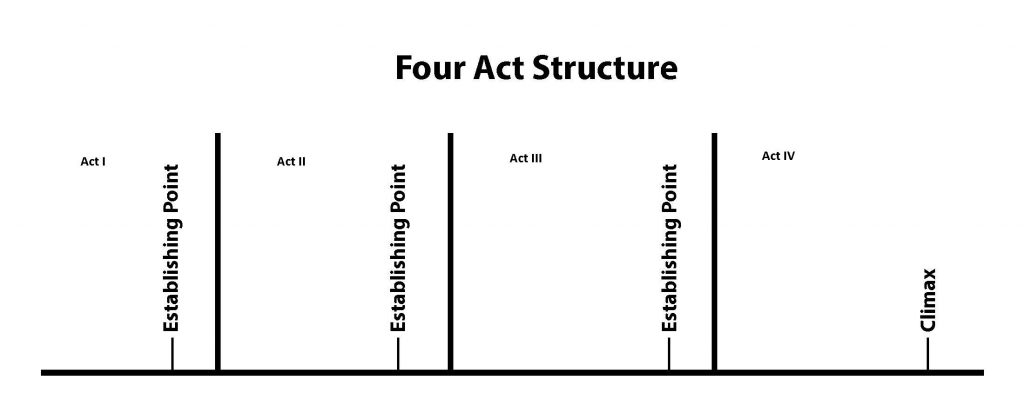
Fundamentally, the difference between the three-act and four-act structures is that act two is now two acts, with each ending in a plot point or establishing point. Act one ends with an establishing point where the hero has a life-changing event that spurs him or her to action, essentially enabling circumstances that lead the hero to launch into the quest or journey that makes up the rest of the story and results inevitably in a confrontation with the antagonist in act one. In act one, there is no midpoint but instead an establishing point that generally consists of a hero-ally confrontation in which the hero is forced to give up his or her flaw. Act two becomes about establishing a relationship with the ally while the hero tries to hold onto his or her flaw and still complete the quest. The establishing point here reveals that the flaw is an obstacle which must be overcome to achieve success.
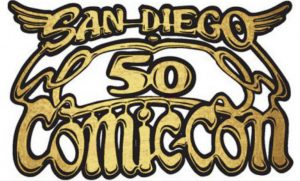 After that establishing point, instead of a second half, we enter act three, which ends with an establishing point where the flaw is finally resolved, and the hero enters the ring against the opponent in preparation for act four’s final confrontation. Act three thus consists of the hero demonstrating the growth of overcoming the flaw or at least conquering and controlling it as he or she prepares with the ally to take on the antagonist. Act four is the climbing into the ring where the hero faces his or her opponent to see who will triumph.
After that establishing point, instead of a second half, we enter act three, which ends with an establishing point where the flaw is finally resolved, and the hero enters the ring against the opponent in preparation for act four’s final confrontation. Act three thus consists of the hero demonstrating the growth of overcoming the flaw or at least conquering and controlling it as he or she prepares with the ally to take on the antagonist. Act four is the climbing into the ring where the hero faces his or her opponent to see who will triumph.
In theory, using four acts makes writing the longer middle easier for writers by breaking it into two logical halves. It also puts more emphasis on a hero-ally confrontation where the flaw is confronted and overcoming begins. This can be a physical or emotional confrontation, but it is a key turning point that functions much like the midpoint in the three-act structure. This often serves to strengthen the relationship between the hero and his or her key ally.
A great example of this four-act structure can be found in the film Rocky, which is considered one of the best-structured films of all time. In act one, Rocky is on the mean streets of Philly and considers himself a loser, but is a nice, bright guy who won’t even stoop to breaking legs for work with loan sharks or other things. Then he gets the chance to fight for heavyweight champion of the world, his establishing point or life-changing event.
In act two, Rocky tries to react to this challenge but is dragged down by his lack of self-confidence. Allies come in the form of his wife, Adrian, and manager, Mickey, who push him to believe in himself, but he can’t do it until he finally confronts the memory of his father telling him he was too ugly and stupid to be anything but a boxer, so he’d better be good. Once he articulates and faces this, he regains a sense of purpose and confidence in an establishing point wherein he determines to prove his father wrong.
Act three is then the training surge when Rocky prepares for the fight with Apollo Creed and begins to think of himself as capable and strong and smart, not a loser, mentally changing and transforming into being ready for the fight.
Act four is the final fight against Creed.
As you can see here, the four-act structure depends more on character development for its turning points than the three-act structure does and really defines and clarifies the characters in a different way, which may be helpful to some of you in structuring your story and thinking it through before writing.
To download a free copy of How To Write A Novel: The Fundamentals of Fiction, click here.
 The following is an excerpt from my book How To Write A Novel: The Fundamentals of Fiction, Chapter 2:
The following is an excerpt from my book How To Write A Novel: The Fundamentals of Fiction, Chapter 2:
A sketch that will inform your outline, the three-act structure nonetheless identifies the core dramatic points of a story. Some of you may be discovery writers like me, preferring to let the story unfold organically. But at some point, you will be required to outline as a professional writer. And when faced with a tight deadline, the more organized you are, the more efficient you can be. The first thing you need to do is understand the dramatic structure that underpins your story. So we are going to talk about a very simple, basic way to identify key points that can help you write more quickly and efficiently to meet a deadline.
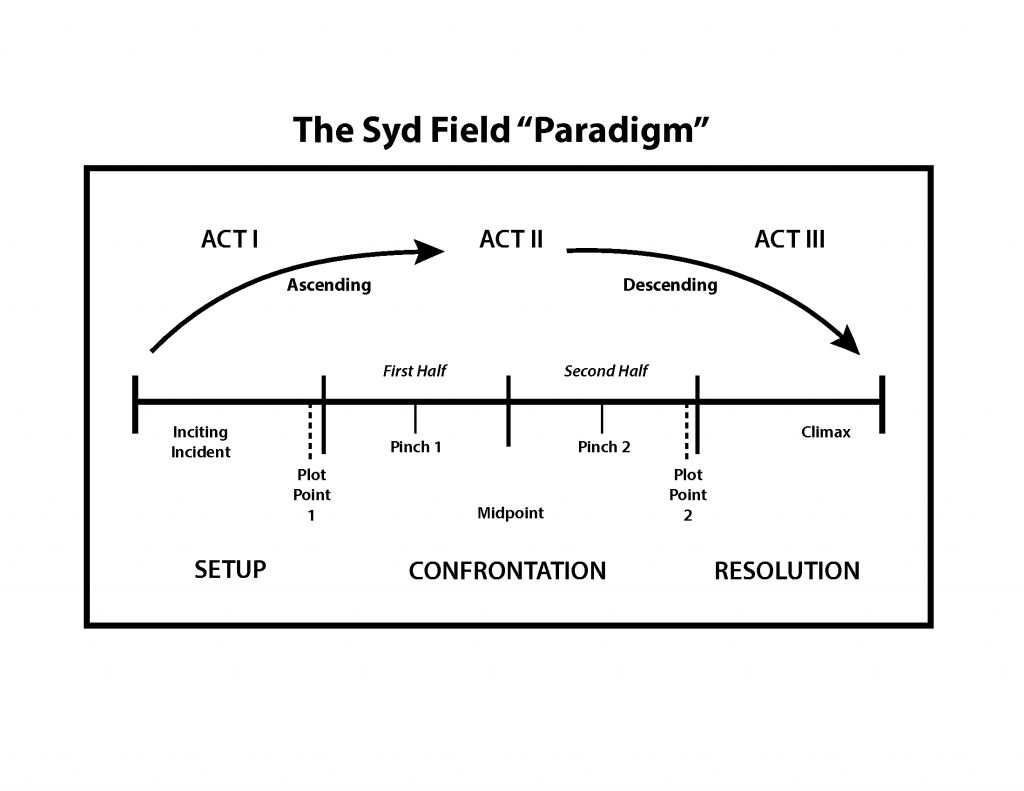
While outlines are multiple pages of detail, the structural diagram will be no more than a brief paragraph or a few sentences describing each required point accompanied perhaps by a paradigm sketch. The paradigm shown is based on Screenplay by Syd Field, a classic writing teaching book employed by many film schools, but in Western literature, the principles also apply to any dramatic story, including those told in prose. The outline is for three acts. In a screenplay, those are act one, which is 30 pages, or a quarter of the text; act two, which is 60 pages, or half; and act three, which is 30 pages, or a fourth. Your page numbers will vary, but the fractions for each portion should wind up roughly the same.
 The key turning points between acts are called plot point 1 and plot point 2. These are events which force the protagonist, and sometimes the antagonist too, to turn in new directions and take new action in pursuit of resolving the conflict. Plot point 1, at the end of act one, will require agency, or action, from the protagonist in pursuit of finding the solution and determining what must be done. Plot point 1 propels the protagonist into act two, which is an ascending action involving discovery and a journey to find the solution and achieve the goal without yet knowing all that is required. In the course of act two, the questions will be answered until you reach plot point 2. Plot point 2, at the end of act two, will occur when the protagonist discovers what must be done and where, and with whom, to resolve the conflict and achieve the goal. And thus, it propels him or her into act two, which is the climactic, descending action to reach that point.
The key turning points between acts are called plot point 1 and plot point 2. These are events which force the protagonist, and sometimes the antagonist too, to turn in new directions and take new action in pursuit of resolving the conflict. Plot point 1, at the end of act one, will require agency, or action, from the protagonist in pursuit of finding the solution and determining what must be done. Plot point 1 propels the protagonist into act two, which is an ascending action involving discovery and a journey to find the solution and achieve the goal without yet knowing all that is required. In the course of act two, the questions will be answered until you reach plot point 2. Plot point 2, at the end of act two, will occur when the protagonist discovers what must be done and where, and with whom, to resolve the conflict and achieve the goal. And thus, it propels him or her into act two, which is the climactic, descending action to reach that point.
 When I write any story, I always start with some idea of what my plot points will be and how it will end, to give me a sense of focus and direction as I write, even when allowing it to unfold organically. Now, just as the overall story has three acts, so will each plot and subplot, and each act. As such, each has a mini turning point called the midpoint or pinch that twists the action a bit and propels us into the second half. In the first act, this is called the inciting incident. This inciting incident often provokes a change in the protagonist’s routine—something new they experience that could either challenge or encourage them. In The Silence of the Lambs (1991), FBI trainee Clarice Starling (Jodie Foster) meets with Dr. Hannibal “the Cannibal” Lecter (Anthony Hopkins). The confrontation of both parties is nerve-wracking. But it intrigues us and sucks in Clarice and leads to the rest of the story. Other examples are Indiana losing the golden idol to Belloq at the opening of Raiders of the Lost Ark, which then sets up a rivalry that drives the later journey as Indiana Jones seeks to get the Ark before Belloq. Morpheus choosing Anderson in The Matrix sets up all that follows after. In The Sixth Sense, without the opening confrontation and gunshot, nothing else that follows could occur.
When I write any story, I always start with some idea of what my plot points will be and how it will end, to give me a sense of focus and direction as I write, even when allowing it to unfold organically. Now, just as the overall story has three acts, so will each plot and subplot, and each act. As such, each has a mini turning point called the midpoint or pinch that twists the action a bit and propels us into the second half. In the first act, this is called the inciting incident. This inciting incident often provokes a change in the protagonist’s routine—something new they experience that could either challenge or encourage them. In The Silence of the Lambs (1991), FBI trainee Clarice Starling (Jodie Foster) meets with Dr. Hannibal “the Cannibal” Lecter (Anthony Hopkins). The confrontation of both parties is nerve-wracking. But it intrigues us and sucks in Clarice and leads to the rest of the story. Other examples are Indiana losing the golden idol to Belloq at the opening of Raiders of the Lost Ark, which then sets up a rivalry that drives the later journey as Indiana Jones seeks to get the Ark before Belloq. Morpheus choosing Anderson in The Matrix sets up all that follows after. In The Sixth Sense, without the opening confrontation and gunshot, nothing else that follows could occur.
In act two, you have a pinch point for each half, and in act three, you have the climactic confrontation before the denouement. These may not be as dramatic as the inciting incident of act one, but they nonetheless inspire the protagonist or antagonist to take further action and move forward on the journey. Whereas the plot points are both major dramatic developments, the inciting incident, midpoint, and pinches can be more internal than external but of significance to the characters’ hearts and minds such that they cause them to change course and move in a new direction or with renewed vigor toward the goal. These are like lesser plot points, in a way, but nonetheless significant points in the framework of the overall dramatic arc that drives your story.
Let’s talk examples. In Star Wars: A New Hope, the inciting incident starts with Darth Vader’s ship attacking Princess Leia’s rebel ship and forcing her to load the Death Star plans into R2-D2, the droid, and send him to escape. He lands on the planet with his companion, C-3PO, and they wind up in the hands of the hero, Luke Skywalker. When Luke discovers a message from a princess that reports danger and points him to a mysterious figure named Obi-Wan Kenobi, he sets off to find out what it means, and that leads him to Old Ben Kenobi, whose shared surname is an obvious clue. Kenobi rescues Luke from Sand People at the midpoint of act one and takes him back to his own home. There, they view the message and Kenobi gives Luke a lightsaber and tells him about the murder of his father, a story Luke never knew. The Empire and a Rebellion, which until now have been mostly rumors far away, have entered Luke’s life, and when Kenobi takes him home, they find that the Jawas who sold Luke’s family the droids have been murdered and torched. Fearing the worst, they race to Luke’s home and find Luke’s aunt and uncle have been murdered and their homestead torched. Plot point 1 is when Kenobi tells Luke they must go rescue the princess together and find a way to deliver the plans hidden in R2-D2.
Act two starts with their trip to Mos Eisley spaceport where they must find passage, and they end up recruiting Han Solo, evading Stormtroopers searching for the droids, and head off for Alderaan. Then, we see Luke in training for the inevitable confrontation, while Vader and Tarkin attempt to extract information from Leia, and ultimately destroy Alderaan. Luke, Han, and Kenobi’s discovery of this is our pinch point for act one. That determines they must rescue Leia themselves and deliver the plans. Then they are caught in a tractor beam and pulled aboard the Death Star. The midpoint comes during the attempted rescue in the Detention Block when they are trapped. The pinch point for act two is when Kenobi confronts Vader to help his friends escape with the droids to the rebellion. Plot point 2 is after they fight their way clear and escape to the rebel base, where the plans reveal the Death Star’s flaw. The Rebels unveiling their attack plan propels us into act three. Act three is the Rebel attack and the Imperial counterattack, and the climax comes as Luke faces off against Vader in the trench run and ultimately destroys the Death Star with surprise help from Han.
So, now that we have seen how this plays out in a story we are all familiar with, it’s time to identify this structure for your story. Keep in mind that this is only a blueprint. Plans can change. As the story evolves, if required, your plot points, as well as pinches and midpoints, and even your climax, may change. The point of this is not to set anything in stone but to have goals to guide your work. It will help direct you as you write and set up each character and point required to reach each marker. If that ultimately requires the markers to change, it’s okay because these are tools to help you achieve a whole.
Here are the things you’ll need to know to develop this paradigm outline.
Who is your protagonist?
Who is your antagonist?
What are their goals?
What are the obstacles each faces in reaching that goal?
What growth must each undergo to make success possible?
And finally, what do you think the final confrontation needs to be?
Answering these questions is just a temporary means to an end. The answers may change, but the idea is to think through key elements of your story to allow you to write with blinders off and have some goal points along the way to work toward. That will allow you to write faster and spend less time wondering what the heck you should do next. As you actually write, these goal points may need to change, and that is okay.
To download a free copy of How To Write A Novel: The Fundamentals of Fiction, click here.
Tomorrow: Part 2-4 Act Structure
Friday: Part 3-How To Structure Scenes
For these and other WriteTips, click here.
 Our tip for today regards using character narrative as a plot device. Now, to begin, let me define character narrative. In the present case I am defining it as the narrative embraced by a character or person as the lens through which they view the world. We see this all the time in politics. The Democrats have a narrative. So do the Republicans. And we hear accusations all the time, not all false, of media bias wherein reporters report angles on stories that match their narrative and leave out the rest. All characters have narratives too, and it is often the differences in narratives that cause conflicts between characters. That being the case, why shouldn’t writers consciously employ narrative as a plot device?
Our tip for today regards using character narrative as a plot device. Now, to begin, let me define character narrative. In the present case I am defining it as the narrative embraced by a character or person as the lens through which they view the world. We see this all the time in politics. The Democrats have a narrative. So do the Republicans. And we hear accusations all the time, not all false, of media bias wherein reporters report angles on stories that match their narrative and leave out the rest. All characters have narratives too, and it is often the differences in narratives that cause conflicts between characters. That being the case, why shouldn’t writers consciously employ narrative as a plot device?
I think they should.
 We often talk of the villains being the hero of their own story. This is narrative. The same is true of every character and where those narratives, or worldviews, clash, is where we find them coming into conflict with one another. So understanding your characters’ narratives and where they come from and how they differ can be a very useful device for helping you shape your stories. And the degree to which you get into the details of it will determine how useful it is.
We often talk of the villains being the hero of their own story. This is narrative. The same is true of every character and where those narratives, or worldviews, clash, is where we find them coming into conflict with one another. So understanding your characters’ narratives and where they come from and how they differ can be a very useful device for helping you shape your stories. And the degree to which you get into the details of it will determine how useful it is.
Good stories have nuance and nuance is depth, so the more you know, the deeper you can go and the richer the results will be. With some minor characters, you may never know their narrative. With supporting characters, you will examine it only on the surface a bit. But with your major characters, the deeper you dig in, the better they will be and the better your story will be for the effort.
So how do you build a character’s narrative? It is similar to how you write a character history or bio. The easiest way is to develop a series of key questions to ask and answer about each character and build from there. The base questions will be the same initially for every character but as you go deeper, unique questions will arise that are unique to specific characters and demand answers. You answer one, another may crop up, rinse and repeat. But the result will be a deeper look inside your characters’ beliefs, motives, personalities, and more. And what you discover in the process will be useful for all kinds of things.
You can use what you glean to help shape your character’s personality, actions, and reactions, even their internal monologue. And the more information you glean, the more specific you are, the more interesting the results will be as you discover key differences between your characters and yourself you never suspected. Building the results into your story will add a lot of layers and depth and nuance that just adds to the experience for readers and makes the characters pop off the page and come more alive like real, unique individuals, not stereotypes or archetypes. There will be nothing run of the mill about characters examined so deeply.
So consider adding examine your characters’ narratives as a possible tool to add to your writer’s toolbox. It’s also a useful tool for interpersonal relationships, but that’s a whole ‘nother blog post which poses a whole different set of potential conflicts, so we’ll leave that be for now. Regardless, I hope it’s a Write Tip that pushes you to think about your stories and characters with a new perspective. For my narrative, that would be very satisfying. For what it’s worth…